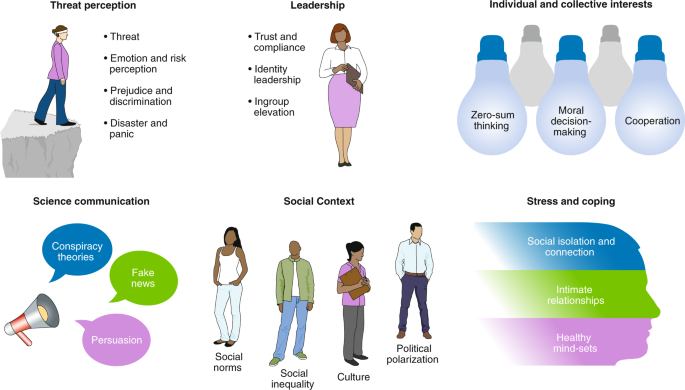In December 2019, a new coronavirus (SARS-CoV-2) emerged, sparking an epidemic of acute respiratory syndrome (COVID-19) in humans, centred in Wuhan, China1. Within three months, the virus had spread to more than 118,000 cases and caused 4,291 deaths in 114 countries, leading the World Health Organization to declare a global pandemic. The pandemic has led to a massive global public health campaign to slow the spread of the virus by increasing hand washing, reducing face touching, wearing masks in public and physical distancing.
While efforts to develop pharmaceutical interventions for COVID-19 are under way, the social and behavioural sciences can provide valuable insights for managing the pandemic and its impacts. We discuss topics that are broadly relevant to numerous stages of the current pandemic to help policy-makers, leaders and the public better understand how to manage threats, navigate different social and cultural contexts, improve science communication, align individual and collective interests, employ effective leadership and provide social and emotional support (see Fig. 1 for summary). For each area, we highlight relevant insights, discuss implications for policy makers, leaders and the public (Box 1) and note areas for future research.
Fig. 1
Infographic depicting a selection of topics from the social and behavioural sciences relevant during a pandemic. Topics covered here include threat perception, social context, science communication, individual and collective interests, leadership, and stress and coping.
Full size image
Due to space constraints, this paper provides a brief summary of each topic. Research topics discussed here were identified by the corresponding authors as potentially relevant to pandemic response and thus are not exhaustive (for a review of research on specific actions, such as handwashing, face-touching and self-isolation, see ref. 2). Furthermore, research on these topics is ongoing and, in many cases, far from settled. We have highlighted relevant findings in each area as well as critical gaps in the literature. Insights and implications for policy should be interpreted with caution because there is very little published social science research on the current pandemic. Thus, our discussion often draws from different circumstances than the current pandemic (for example, laboratory experiments examining hypothetical scenarios), and the quality of the evidence cited varies substantially (for example, correlational studies vs field experiments; single studies vs systematic reviews of substantial evidence). In the sections that follow, we try to describe the quality of evidence to facilitate careful, critical engagement by readers. We call for the scientific community to mobilize rapidly to produce research to directly inform policy and individual and collective behaviour in response to the pandemic.
Threat perception
Historically, infectious diseases have been responsible for the greatest human death tolls. For example, the bubonic plague killed approximately 25% of the European population3. In this section, we discuss how people are likely to perceive and respond to threats and risk during a pandemic and downstream consequences for decision-making and intergroup relations.
Box 1 Social scientific insights for COVID-19 pandemic response
We highlight some insights for public health experts, policy makers, and community leaders.
-
A shared sense of identity or purpose can be encouraged by addressing the public in collective terms and by urging ‘us’ to act for the common good.
-
Identifying sources (for example, religious or community leaders) that are credible to different audiences to share public health messages can be effective.
-
Leaders and the media might try to promote cooperative behaviour by emphasizing that cooperating is the right thing to do and that other people are already cooperating.
-
Norms of prosocial behaviour are more effective when coupled with the expectation of social approval and modelled by in-group members who are central in social networks.
-
Leaders and members of the media should highlight bipartisan support for COVID-related measures, when they exist, as such endorsements in other contexts have reduced polarization and led to less-biased reasoning.
-
There is a need for more targeted public health information within marginalized communities and for partnerships between public health authorities and trusted organizations that are internal to these communities.
-
Messages that (i) emphasize benefits to the recipient, (ii) focus on protecting others, (iii) align with the recipient’s moral values, (iv) appeal to social consensus or scientific norms and/or (v) highlight the prospect of social group approval tend to be persuasive.
-
Given the importance of slowing infections, it may be helpful to make people aware that they benefit from others’ access to preventative measures.
-
Preparing people for misinformation and ensuring they have accurate information and counterarguments against false information before they encounter conspiracy theories, fake news, or other forms of misinformation, can help inoculate them against false information.
-
Use of the term ‘social distancing’ might imply that one needs to cut off meaningful interactions. A preferable term is ‘physical distancing’, because it allows for the fact that social connection is possible even when people are physically separated.
Threat
One of the central emotional responses during a pandemic is fear. Humans, like other animals, possess a set of defensive systems for combating ecological threats4,5. Negative emotions resulting from threat can be contagious6, and fear can make threats appear more imminent7. A meta-analysis found that targeting fears can be useful in some situations, but not others: appealing to fear leads people to change their behaviour if they feel capable of dealing with the threat, but leads to defensive reactions when they feel helpless to act8. The results suggest that strong fear appeals produce the greatest behaviour change only when people feel a sense of efficacy, whereas strong fear appeals with low-efficacy messages produce the greatest levels of defensive responses.
Another challenge is that people often exhibit an ‘optimism bias’: the belief that bad things are less likely to befall oneself than others. While optimism bias may be useful for avoiding negative emotions9, it can lead people to underestimate their likelihood of contracting a disease10 and to therefore ignore public health warnings11. Communication strategies must strike a balance between breaking through optimism bias without inducing excessive feelings of anxiety and dread.
Emotion and risk perception
Sound health decisions depend on accurate perceptions of the costs and benefits of certain choices for oneself and for society12,13. Emotions often drive risk perceptions, sometimes more so than factual information14,15. An emotional response to a risky situation can influence thinking in two stages16. First, the emotion’s quality (for example, positive vs negative) focuses people on congruent information (for example, negative information when feeling negative). That information, rather than the feeling itself, is then used to guide judgment at the second stage. For example, smokers exposed to more negative emotional health warnings experienced more negative emotion toward warnings and smoking, spent more time examining warnings and recalled more risks, with subsequent effects on risk perception and quitting intentions17,18. As negative emotions increase, people may rely on negative information about COVID-19 more than other information to make decisions.
In the case of strong emotional reactions, people may also ignore important numeric information such as probabilities19 and a problem’s scope20. Negative framing captures attention, especially for people who are less mathematically skilled21. The media usually report on COVID-19 negatively—for example, by reporting the number of people infected and those who die—as opposed to those who recover or experience only mild symptoms. This may increase negative emotion and sensitize people to otherwise neglected risks for themselves or others. Research is needed to determine whether a more positive frame could educate the public and relieve negative emotions while increasing public health behaviours.
Prejudice and discrimination
The experience of fear and threat has ramifications not only for how people think about themselves, but also how they feel about and react to others—in particular, out-groups. For instance, being threatened with disease is often associated with higher levels of ethnocentrism22; greater fear and perceived threat are associated with greater intolerance and punitive attitudes toward out-groups23,24,25. Highlighting group boundaries can undermine empathy with those who are socially distant26,27 and increase dehumanization28 or punishment29.
The bubonic plague, for example, unleashed massive violence in Europe, including the murder of Catalans in Sicily, clerics and beggars in some locations, and pogroms against Jews, with over a thousand communities eradicated30. Although not every pandemic leads to violence, disease threat can nonetheless give rise to discrimination and violence against stigmatized or scapegoated groups. Already, there have been reports of physical attacks on ethnic Asian people in predominantly White countries, and some government officials mis-characterize SARS-CoV-2 as the ‘Wuhan’ or ‘Chinese virus’31.
Conversely, a global pandemic may also create opportunities to reduce religious and ethnic prejudice. Coordinated efforts across individuals, communities and governments to fight the spread of disease can send strong signals of cooperation and shared values, which could facilitate reorganization of previously considered out-groups and in-groups into a single community with a common destiny. This ‘superordinate categorization’ is most effective when everyone is of equal status32. These cooperative acts are already unfolding in the current pandemic. For example, 21 countries donated medical supplies to China in February, and China has reciprocated widely. Highlighting events like these could improve out-group attitudes33 and foster further international cooperation.
Disaster and ‘panic’
There is a common belief in popular culture that, when in peril, people panic, especially when in crowds. That is, they act blindly and excessively out of self-preservation, potentially endangering the survival of all34. This idea has been used to explain responses to the current COVID-19 outbreak, most commonly in relation to the notion of ‘panic buying’. However, close inspection of what happens in disasters reveals a different picture. Certainly, some people do act selfishly and some, especially those who are particularly vulnerable, may experience more distress. But cooperation and orderly, norm-governed behaviour are common across a range of emergencies and disasters; and there are many instances when people display remarkable altruism35. There is already evidence that mutual aid groups among the public have become widespread in response to Covid-1936. Indeed, in fires37 and other natural hazards38, people are less likely to die from over-reaction than from under-reaction, that is, not responding to signs of danger until it is too late.
In fact, the concept of ‘panic’ has largely been abandoned by researchers because it neither describes nor explains what people usually do in disaster39. Instead, the focus has shifted to the factors that explain why people cooperate rather than compete in response to a crisis35. One of these factors is an emerging sense of shared identity and concern for others, which arises from the shared experience of being in a disaster40. This feeling can be harnessed by addressing the public in collective terms and by urging ‘us’ to act for the common good41.
Conversely, the sense of shared identity can be undermined by representing others as competitors. This can happen with images of empty shelves and stories of panic buying, which suggest that others are only looking out for themselves, thus prompting a desire for doing the same. Stocking up on supplies is adaptive in preparation for potential self-isolation42. However, use of the notion of panic can be actively harmful. News stories that employ the language of panic often create the very phenomena that they purport to condemn. They can foster the very individualism and competitiveness that turns sensible preparations into dysfunctional stockpiling and undermine the sense of collective purpose which facilitates people supporting one another during an emergency.
